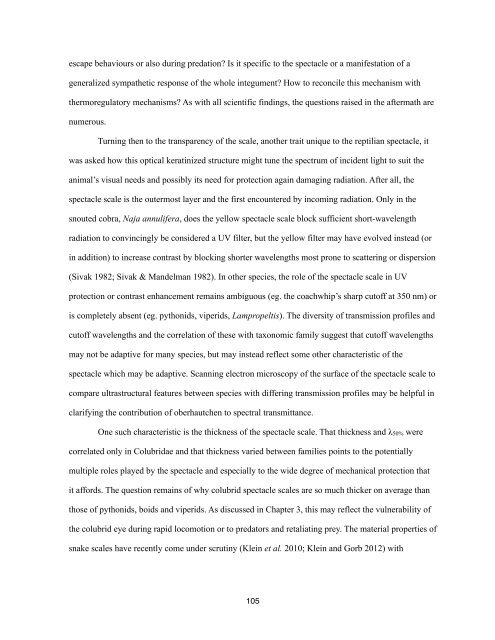Chapter 1, The Reptilian Spectacle - UWSpace - University of ...
Chapter 1, The Reptilian Spectacle - UWSpace - University of ...
Chapter 1, The Reptilian Spectacle - UWSpace - University of ...
Create successful ePaper yourself
Turn your PDF publications into a flip-book with our unique Google optimized e-Paper software.
escape behaviours or also during predation? Is it specific to the spectacle or a manifestation <strong>of</strong> a<br />
generalized sympathetic response <strong>of</strong> the whole integument? How to reconcile this mechanism with<br />
thermoregulatory mechanisms? As with all scientific findings, the questions raised in the aftermath are<br />
numerous.<br />
Turning then to the transparency <strong>of</strong> the scale, another trait unique to the reptilian spectacle, it<br />
was asked how this optical keratinized structure might tune the spectrum <strong>of</strong> incident light to suit the<br />
animal’s visual needs and possibly its need for protection again damaging radiation. After all, the<br />
spectacle scale is the outermost layer and the first encountered by incoming radiation. Only in the<br />
snouted cobra, Naja annulifera, does the yellow spectacle scale block sufficient short-wavelength<br />
radiation to convincingly be considered a UV filter, but the yellow filter may have evolved instead (or<br />
in addition) to increase contrast by blocking shorter wavelengths most prone to scattering or dispersion<br />
(Sivak 1982; Sivak & Mandelman 1982). In other species, the role <strong>of</strong> the spectacle scale in UV<br />
protection or contrast enhancement remains ambiguous (eg. the coachwhip’s sharp cut<strong>of</strong>f at 350 nm) or<br />
is completely absent (eg. pythonids, viperids, Lampropeltis). <strong>The</strong> diversity <strong>of</strong> transmission pr<strong>of</strong>iles and<br />
cut<strong>of</strong>f wavelengths and the correlation <strong>of</strong> these with taxonomic family suggest that cut<strong>of</strong>f wavelengths<br />
may not be adaptive for many species, but may instead reflect some other characteristic <strong>of</strong> the<br />
spectacle which may be adaptive. Scanning electron microscopy <strong>of</strong> the surface <strong>of</strong> the spectacle scale to<br />
compare ultrastructural features between species with differing transmission pr<strong>of</strong>iles may be helpful in<br />
clarifying the contribution <strong>of</strong> oberhautchen to spectral transmittance.<br />
One such characteristic is the thickness <strong>of</strong> the spectacle scale. That thickness and λ50% were<br />
correlated only in Colubridae and that thickness varied between families points to the potentially<br />
multiple roles played by the spectacle and especially to the wide degree <strong>of</strong> mechanical protection that<br />
it affords. <strong>The</strong> question remains <strong>of</strong> why colubrid spectacle scales are so much thicker on average than<br />
those <strong>of</strong> pythonids, boids and viperids. As discussed in <strong>Chapter</strong> 3, this may reflect the vulnerability <strong>of</strong><br />
the colubrid eye during rapid locomotion or to predators and retaliating prey. <strong>The</strong> material properties <strong>of</strong><br />
snake scales have recently come under scrutiny (Klein et al. 2010; Klein and Gorb 2012) with<br />
105
















